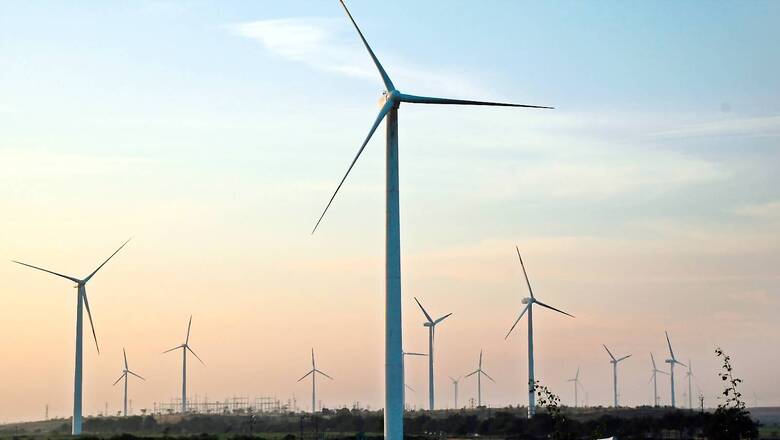
views
India is working towards achieving 500 GW of installed electricity capacity from non-fossil sources by 2030. So far, a total of 172.72 GW of capacity from non-fossil fuel sources has been installed in the country as on October 10, 2022, according to government data.
India stands fourth globally in Renewable Energy Installed Capacity (including large hydro), fourth in Wind Power capacity and fourth in Solar Power capacity (as per REN21 Renewables 2022 Global Status Report).
A total of 14.21 GW of Renewable Energy (RE) capacity was added, during the period from Jan to Oct 2022 as compared to capacity of 11.9 GW added during the same period in 2021. A total of 151.94 BU have been generated from RE sources during the period Jan to Sep 2022 as compared to the 128.95 BU during the same period in 2021.
As the budget 2023 is scheduled to be presented by Finance Minister Nirmala Sitharaman on February 01, the energy sector has made some suggestions and urged some initiatives to address the demands.
Amit Jain, MD, Engie India, said that the share of renewable energy in the overall energy mix in India has been on the rise and India is well on course to reach the current target of 500 GW of renewable capacity to meet 50% of its energy requirements by 2030.
“To meet this ambitious target, Central Electricity Authority (CEA) estimates an investment of Rs 2.44 trillion would be required and a significant portion of this would be in the form of FDIs. The budget can look to extend policies that can facilitate renewable energy investment. These include tax policies (such as lower taxes on profits and GST on clean power sales), and support foreign currency investments,” Jain said.
Also Read: Budget 2023 Expectations: Will Home Buyers Get More Relief? Here’s What Real Estate Sector Wants From FM
Jain suggested that the government can consider innovative financing mechanisms ensuring that renewable developers are able to raise long term debt in foreign currency or through the international bond market whilst requesting the domestic banks and other financial institutions raise their risk instrument offerings and financing capacity for renewable projects.
Other innovations the government can consider that can provide an impetus to the growth of renewable energy could be virtual corporate power purchase agreements, which can derisk to some extent sale of power in the open access market; and an energy transition mechanism and a robust carbon credit market, he added.
Pratik Agarwal, managing director, Sterlite Power and director of Serentica Renewables, said, “India has a large PF corpus of more than Rs 17 lakh crores in EPFO. Budget 2023 should focus on mobilising a portion of this corpus as debt or equity in greenfield infra projects. This will bring better returns to pensioners, and home-grown abundant capital to project developers. In the world of energy, policy push makes a big difference. Therefore, we hope to see an additional emphasis and budgetary support to promote new areas of energy, like offshore wind and grid balancing solutions including hydro.”
With India’s goal of becoming a $5 trillion economy by 2025, experts highlighted that there is a need to continuously accelerate investments by the government to expand India’s infrastructure sector.
Anil Chaudhry, zone president, India and CEO and MD, Schneider Electric India, said, “Focus on adoption of energy efficient sustainable solutions and faster digitisation by leveraging AI (Artificial Intelligence) and other advanced technologies can prove to be a game changer in India’s infrastructure sector.”
“We believe that in the budget, greater focus needs to be put on attracting additional investments by the private sector in expanding India’s Infrastructure growth through greater public private partnerships. A digitally enabled and connected infrastructure ecosystem in India would help support India’s push towards becoming net zero by 2070,” Chaudhry added.
Some industry experts underlined the need for Production Linked Incentive for wind turbine manufacturers. A total capacity addition of 1761.28 MW has been achieved during the period of January to October 2022.
Inder Bhambra, country head, BD and sales, Envision Energy India, said, “The industry expects that the budget will introduce a PLI programme for wind turbine manufacturers, which will subsequently increase the output of domestic equipment, thereby lowering the cost of installation.”
Also Read: Budget Expectations 2023: Will Your Restaurant Bill Decrease? Here’s What F&B Industry Wants From FM
Bhambra also urged that the government should consider treating Renewable Energy Certificates similar to carbon credits and grant favourable tax on income derived from them.
“The government must take steps to bolster India’s renewable energy capacity by bringing down the GST rate on sale of wind and solar equipment. With consistent fiscal support, we are positive that the Indian renewable industry can double its renewable power capacity by 2027,” Bhambra added.
Moreover, the draft National Repowering Policy for Wind Power Projects, 2022 has been issued for stakeholders consultation by the government. The objectives of the policy are optimum utilisation of wind energy resources by maximising energy (kWh) yield per sq.km of the project area and utilising the latest state-of the art onshore wind turbine technologies.
Read all the Latest Business News here




















Comments
0 comment